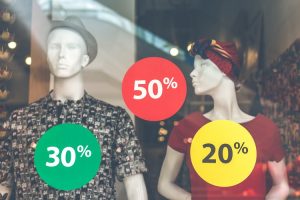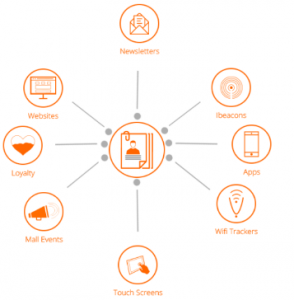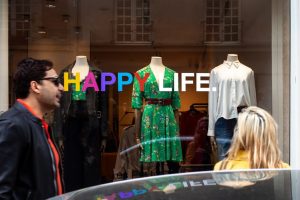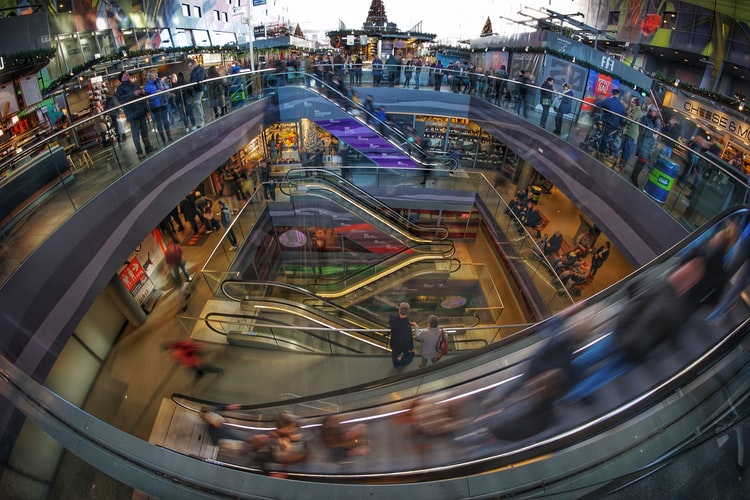While at the mall this weekend, a friend casually remarked “I wish somehow I could do an internet search in a physical mall, wouldn’t that be so cool?!” She then continued jokingly, “Hey mall virtual assistant, find me a fuchsia pink lace sheath dress, size 6, below 40 dollars….tell me which stores have it”. This reality my friend was joking about isn’t actually all that far from our current state. Whether you have a semi-compulsive shopping disorder like me (hitting the mall when it rains or when it doesn’t) or you can barely survive grocery shopping once a month, it would be interesting to see the retail landscape change in a way which was not thought possible a few years ago.

While its becoming commonplace for bigger stores to deploy IoT sensors in refrigeration units in stores to detect food spoilage or tracking shopper “hot spots”, a few have more extensive plans to use IoT to track shopping behavior and engaging customers to increase footfalls. This could mean real-time in-store promotions or gathering data on shopping patterns, for example. It could also mean gathering customer information and detailed personas from in-person shopper data that enables companies to create highly effective and detailed CRM programs.
The ‘Internet of Things’ (or IoT) in retail is the technology that will drive truly inter connected, Omni channel experiences. It could be about connecting a sales assistant’s tablet to an e-commerce site, a customer’s mobile to a store window display, or an RFID clothing label to a smart changing room.
Although the benefits we always discuss are focused towards the companies and their ROI, it would be interesting to note and highlight what it does for the consumer and how it makes their life easier as well as more convenient. It’s not rocket science, a strong “win-win” formula is all that is required. It may have a few more caveats, however, as we dig deeper.

E-commerce is thriving because of the convenience and the multitude of options it provides, not to mention the cost savings. If this experience could be replicated to a certain extent on the physical plane, we could see more people heading to their nearby mall. Human beings are in essence, social beings, so shopping just like eating out is an experience all in itself. We can find a recipe online and make a Thai green curry at home, but we still sometimes prefer to pay a nominal cost to relish it outside in a fancy restaurant because of the added visual and social stimulation it provides. So, while shopping online is great, we would want to go to a physical mall and shop because of the whole shopping experience that it may provide including the feel good shopping endorphins rushing through our body. Making it an “event” instead of letting it be an everyday “occurrence” will make the whole difference in the retail sector.
Since traditional retail has a way of touching every life closely at any age, demographic or culture, some companies today are trying out an array IoT solutions in order to improve operations, reduce theft, increase purchases through cross selling, enable and improve inventory management, and most importantly help in enhancing the consumer’s shopping experience to battle an ever growing e-commerce marketplace.
Retailers started beaming promotions straight to shopper’s smart phones through their Retailer specific apps some time ago, but it wasn’t until recently that we have developed the ability to recognize customers through their smart phone apps pinging off wifi and beacon signals geo-locating a person on the premises. This enables targeted promotions, ads, and offers based of the cumulative shopping history, favorites, or shopping list.
Enhancing the customer experience will drive foot traffic and virtual traffic to build interactive experiences with retailers and even more data creation when linked to the entire shopping mall.
360 Degree
Data and Analytic practices should help design, develop and deploy Cloud data models that provide the basis of a valuable shopper database.
Asset value is no longer determined by the asset only: it is largely influenced by the ability of a mall to reach and activate its customer base.
As e-commerce players know 100% of their customers, malls typically are not capable of engaging with their visitors. We believe that any mall should build up a database of at least 25% of their catchment area. This will enable them to engage with their shoppers, and (re)activate them to visit the mall.
We can design architecture to include all digital channels and smart building systems that malls can use to collect valuable shopper data.

All shopper data can be stored on Cloud and in one single customer record:
- Demographics (for example: age, gender, city, likes, date of birth)
- Interests (for example: liked stores, liked categories)
- Behavior (for example: mall visits, store visits, purchases)
The scope and magnitude of success in traditional retail lies in identifying gaps and using them as opportunity to get the charm back in this sector .
Scenario 1 – The Experience Opportunity
With new technologies coming of age, there is an opportunity for malls to become the technical provider to each Retailer, enabling and delivering affordable mall-wide data networks, Shopper applications, and analytics that retailers can subscribe to for promotional pushes to smart phones through a permission-based mall apps, kiosks and Mall web sites. This will help in creating a unified and consistent experience across all channels.
Consider this – as Julie walks through the mall’s front entrance, the mall app on her smart phone launches automatically. The shopping list she has created shows the retailers that can meet her shopping needs and any offers they have currently available. She chooses the shoe retailer that’s having a 25% off sale and her favorite summer wear shop. As she is following the highly efficient route that the app has provided for her, she gets a ‘Members-Only’ notification from her favorite food court restaurant: ‘Pad Thai combo 50% off until 12:30 and she stops for lunch. Another alert comes in and notifies her of how many Member points she accumulated on her visit and that her Car Valet is ready and waiting outside the entrance. She accepts the Valet notification and even adds a Tip as she messages back with a ‘be there in 5’.
At the end of her trip, Julie is already looking forward to her next mall visit by taking a quick survey that earns her member points for rating her experience.
Scenario 2 – The Personalization Opportunity
How does the idea of “logging” into the mall sound? Elevating retail to the next step would mean thinking beyond the ordinary. It’s about identifying every shopper as an entity. When this “entity” steps into the mall, being able to welcome them with a greeting message on their phones can be a launch point that propels a multi-faceted experience digital experience in a physical space.

Knowing attributes like shopper’s birthday or anniversary can enable certain suggestions to be made in regards to the things they would love/need to buy based on past recorded tastes and affinity or their favorite restaurant. It’s about providing shoppers with a Concierge experience:
- Through the mobile or tablet provide a Reservation capability to reserve lockers, strollers, wheelchairs, movie tickets or restaurant reservations.
- Think Open table meets mall resources. Simple reservation capabilities and integration to vendor sites can keep shoppers at the mall longer.
- New patterns of member use can predict needs prior to getting to the mall. Favorite eatery, special needs, or strollers can be preset so no prep time is needed upon arrival.
- Provide discounts for renting these services if done through the mall app. Slightly higher if done in person and no guarantees of availability.
Tune your marketing messages to hit each individual shopper or shopper segments in order to improve response rates, personalize messages to make shoppers feel appreciated, and re-target shoppers based on past behavior and reactivate them to visit your mall are all features within reach of today’s IoT and mobile technologies.
Plug-ins can effectively engage shoppers to increase repeat visits, dwell time and loyalty as well as reach shoppers on their favorite device to collect behavioral, interests and demographic data from digital channels and in-mall systems.
Scenario 3 –The Universalization Opportunity
We all know how much kids detest it when their parents continue to persue shopping aisles to get that perfect article of clothing. They tend to get tired, cranky, and hungry (often all at the same time). Most times they are just bored. To them, shopping is only good if it is for toys. Think of designated places for them to have group fun like dancing or games, provide free movies or content, and give their parents a quick break all in order to keep visitors with families on the grounds longer. We can easily do these with current technology already on the market:
- Integrating to download or stream exclusive video content only available on the property.
- Cloud and network integration can deliver content to any mobile or iPad device. (Think of hotel type access with log in / opt in Free T&C’s)
- Companies can gather view data, preferences and time of use to know what is most effective at entertaining children and keeps their parents from receiving notifications summoning them back to the location.
- Provide analytics on customer and any profile information usable for marketing to the shoppers again for interests or other services/events for their kids coming up in the future.

The Way Forward
Re-tail needs to Re-vamp, Re-define and Re-write the rules in order to get its glory back. Its 2019 and old norms are bound to fail. The consumer has evolved multi-fold and demands more in order to be pleased. They have been pampered and spoiled by the wave of e-commerce; they demand nothing but the best. They demand the highest quality at best prices, and with today’s social media reach, consumers can either make you or destroy you completely. It is crucial that the experience of the malls of old get tossed out and they begin to utilize new technologies to stem the rising tide of e-commerce.
The components that are essential to make the next wave of retail a success will be covered soon in the next article….thank you for reading and happy shopping!
By Bhawna Vats, Director of Operations @ Clovity, July 9th, 2019


